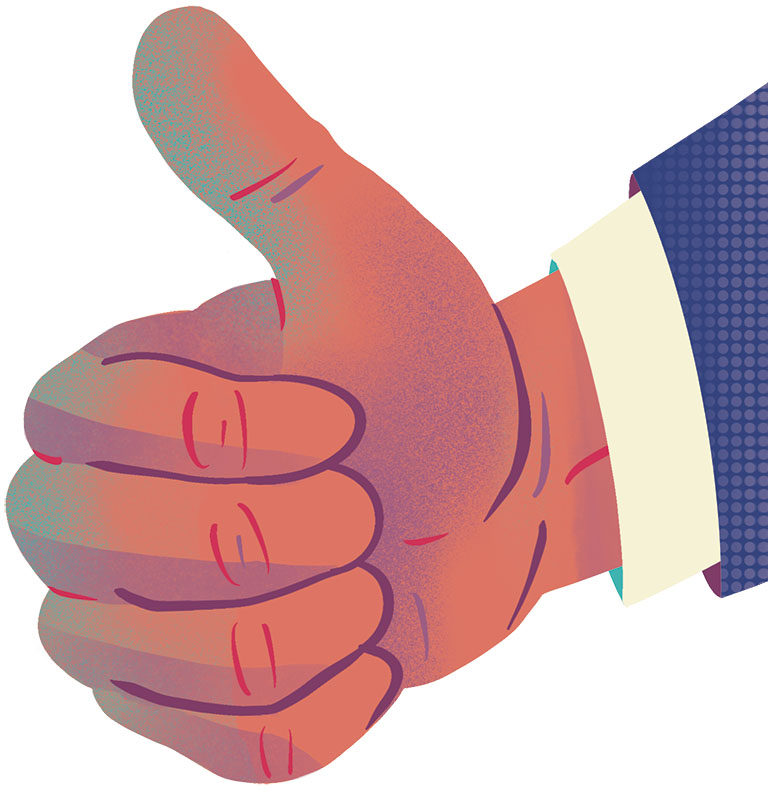
Can work be your happy place?
Fall/Winter 2021 issue
Elevating mood in the workplace requires a team approach.
We spend a lot of time thinking about work: at least a third of our day if we’re employed and probably more if we're searching for a job and worrying about it if we’re not.
Karl Marx theorized that the “alienation” of people from their labour (what they made, how they made it and with who) was depriving them of their very humanity. Work-life balance gurus, on the other hand, suggest that a separation of the two is necessary. Others say that if we can find passion through our job we’ll never work a day in our lives.
Whether it’s in the office, out in the field, in a truck, or at a school, clinic or jobsite — even the kitchen table during the pandemic — work is work, but if we are aiming to achieve happiness in life surely we must also seek some of it when we’ve got our nose to the grindstone.
It is possible, says Symone Loney, a Mount Royal alumna (Bachelor of Arts — Psychology, 2012) who now works as a human resources business partner with Coca-Cola Canada Bottling Ltd.
“I’m a person who finds happiness in accomplishing goals, completing tasks and human interaction, and someone who believes work is a great contributor to my personal fulfilment,” Loney says. “All of this, in turn, leads to feelings of happiness.”
Dr. Christian Cook, PhD, associate professor of human resources at MRU’s Bissett School of Business and academic director, Academic Development Centre, looks at happiness in terms of “intrinsic motivators,” citing the work of Dr. Frederick Herzberg, PhD, whose research in motivation theory from the 1950s through to the 1980s was considered to be pioneering, and also that of Daniel Pink, who has written six books on business and human behaviour.

“Ideally, people are working in roles where they are happy, but that is different than expecting a job to make you happy."
— Christian Cook, PhD, associate professor of human resources
“I think that happiness is tightly coupled to engagement,” Cook says. “Particularly these days, the bosses, colleagues and stakeholders we work with every day are material characters to how happy (or unhappy) or engaged employees are. More than ever, employees need to feel they are seen as people, rather than ‘just’ a worker or employee.”
Cook “gets nervous,” however, when people put pressure on themselves, thinking their job needs to make them happy at work and they have to be working at their passion.
“Ideally, people are working in roles where they are happy, but that is different than expecting a job to make you happy. We are whole people, and fascinating ones at that. While I appreciate that work is important to us, and for some even part of our identity, all of the other aspects of our life contribute to our overall sense of happiness.”
Happiness or unhappiness in a job environment, as in life, is complicated.
“I have worked in HR for a very long time, and rarely are the issues that arise connected only to work issues; usually, they are tied to worker relationships, worker behaviours and the work environment. And while much more common, those can also be the more challenging things to ‘fix,’ ” Cook says.
Dr. Uthpala Senarathne Tennakoon, PhD, suggests redefining what we think of happiness and focusing more on being content rather than joyful. An associate professor of human resources at MRU, Tennakoon says, “Achievements, recognition and sometimes the simple completion of the work as you planned it to be would lead to happiness at work, but I believe it has more to do with satisfaction, which then leads to happiness.”
She suggests factors such as what type of work a person does, whether they have a choice in selecting that work and workplace, whether the work is connected to their values and what energizes them all play a part.
“But, I am not sure if happiness should be the goal of a job. Happiness in a job may be more indirect through satisfaction, accomplishment and recognition.”

Employers or employees: Who owns happiness?
Cook believes that everyone has a responsibility to provide a respectful work environment. Those courteous conditions are necessary (though admittedly not sufficient), as a first step toward happiness. Employees want to feel they have the tools to succeed, to feel cared for and that their employer has their back.
“Employees take their cues from their employers and leaders and naturally emulate those behaviours and values; so, the tone at the top is also important.”
Tennakoon agrees that happiness in the workplace is a shared responsibility, beginning with employees choosing the right job and workplace for them, and employers selecting the right people for the job and the organization.
“If you don't get a good match with the individual's personality and values with the organization's culture, plus the work the person is supposed to be doing, there is going to be unhappiness, rather than happiness,” she says.
“From an organization's point of view, there is an ongoing responsibility to make sure that individuals are treated fairly and ethically, and understand that the whole self of the individual comes to work. That has never been more evident than during the COVID-19 pandemic.”
Some organizations, Tennakoon notes, are intentional about creating happiness opportunities, scheduling things like fun work gatherings and providing arcade games, meals and entertainment. These are beneficial if they align with organizational and individual employee values.
Other areas organizations can focus on to increase happiness, suggests Tennakoon, include: creating an inclusive culture; fostering recognition when due; improving bosses’ performance through leadership training; understanding work-life balance; offering opportunities for advancement; and empowering employees.
Alumna Loney says, “I believe promoting an environment of openness and acknowledging that we all have low days allows more room to experience the high (happy) days as well.”
“Endorsing mental health initiatives and having difficult, vulnerable conversations can foster healthy work relationships, inevitably allowing employees to feel understood and supported, which can lead to a ‘happier’ workplace.”
Meanwhile, employees can try to create their own happiness by making efforts to better understand their co-workers, as well as themselves, and what may positively or negatively affect their happiness levels. Negative factors can include being rushed at work, unrealistic deadlines, feeling undervalued and unsafe work environments.
“Finding ways to mitigate stressors for themselves and others can be a way to improve happiness for employees and their co-workers in the workplace,” she says.
Ultimately, the right fit at the right organization and everyone doing their part contributes to happiness at work. It really is in everyone's hands.
Reach out
It’s impossible to be happy all the time, of course, but everyone deserves to feel good about themselves. Connections help. Reach out to your alumni family.
If you feel like you are needing a bit more support for your happiness and mental wellbeing, there are resources available to you.
View resources
Read more Summit
The reflections you see may not be accurate
Social media is great for making connections, but the constant comparisons with others can be harsh.
READ MORE




